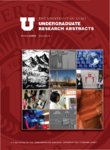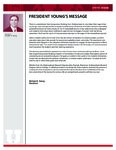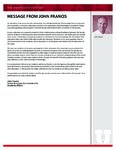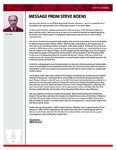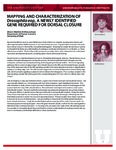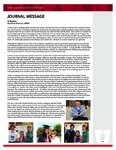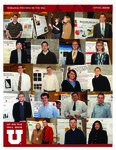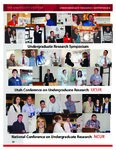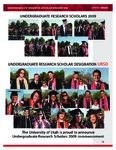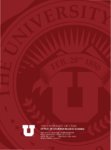Contents | 6 of 17
Undergraduate Abstracts of undergraduate research abstracts vol 9 - Part 1
| Title | University of Utah Undergraduate Research Abstracts, Volume 9, Spring 2009 |
| OCR Text | Show A Message from President Young.....2 A Message from John Francis.....3 A Message from Steve Roens.....4 Undergraduate Abstracts.....5 A Message from Jill Baeder.....69 Research Posters on the Hill.....70 Charles H. Monson Prize Winner.....99 Undergraduate Research Conferences.....104 Undergraduate Research Scholars.....105 Psychology Senior Thesis Program.....106 Honors Program.....114 Alphabetical Index.....187 |
| Subject | University of Utah -- Students -- Periodicals |
| Publisher | J. Willard Marriott Library, University of Utah |
| Date | 2009 |
| Type | Text |
| Format | application/pdf |
| Language | eng |
| Rights Management | Digital image © copyright 2009, University of Utah. All rights reserved. |
| Holding Institution | Office of Undergraduate Studies Sill Center 195 S. Central Campus Dr. Salt Lake City, UT 84112 Office of Undergraduate Studies Sill Center 195 S. Central Campus Dr. Salt Lake City, UT 84112 |
| Source Material | Bound journal |
| Source Physical Dimensions | 14 cm x 21 cm |
| ARK | ark:/87278/s6j966gm |
| Temporal Coverage | Spring 2009 |
| Setname | uu_urop |
| ID | 417424 |
| Reference URL | https://collections.lib.utah.edu/ark:/87278/s6j966gm |
Page Metadata
| Title | Undergraduate Abstracts of undergraduate research abstracts vol 9 - Part 1 |
| OCR Text | Show THE UNIVERSITY OF UTAH MAPPING AND CHARACTERIZATION OF Drosophila eop, A NEWLY IDENTIFIED GENE REQUIRED FOR DORSAL CLOSURE Neural tube defects (such as spina bifida) result from a failure to complete neural groove closure and affect approximately 40,000 neonates in the United States per year. A good model system for this prob-lem is dorsal closure in the fruit fly Drosophila melanogaster. Studying the simpler dorsal closure system in Drosophila facilitates an understanding of analogous molecular mechanisms in vertebrates, i.e. those affecting neurulation. This fruit fly model system also provides other useful information for understand-ing human developmental events, including palate closure and wound healing. Dorsal closure is a vital developmental event in Drosophila melanogaster embryos. Dorsal closure occurs midway through embryogenesis; during this process, the lateral epithelial sheets elongate over the embryonic amnioserosa, ultimately meeting and fusing along the dorsal midline. One of the signaling pathways that is known to play a major role in dorsal closure is the JNK (Jun N-terminal kinase) cascade. One of the important roles of the JNK signaling cascade is the transcriptional activation of dpp (decapen-taplegic) in leading edge cells. The JNK cascade triggers the secretion of Dpp protein from leading edge cells, which activates signaling in adjacent cells to induce their elongation. Punt is a Dpp receptor in the Dpp signaling cascade; flies lacking punt (the corresponding gene for Punt) result in a dorsal-open phe-notype. I am attempting to map eop (enhancer of punt), a gene that interacts with punt during dorsal closure. eop was originally isolated on a chromosome with two lethal mutations, keph (kaphalea) and norma. Flies with mutations in keph, norma or punt have been isolated; each mutation results in homozygous lethali-ty associated with very mild cuticular defects. Recombination techniques were used to create a punt keph double mutant. The punt keph lethal phenotype was assessed subsequently via cuticular analysis for the gross defects in dorsal closure that were observed in put eop double mutants. Using this method, I have shown that keph has no enhancing effect on the punt cuticular phenotype, indicating that the keph lethal mutation is not be the source of eop enhancement. Previous studies have shown that norma is also not the source of enhancement. I am proceeding to characterize the lethal period and pheno-types of keph and norma. Single Nucleotide Polymorphism mapping will be used to locate eop for the eventual purpose of cloning the gene. Once the gene has been cloned, it will be further investigated to determine how it interacts with punt. In the long term, we expect that study of the JNK and Dpp signal-ing cascades in Drosophila dorsal closure will lead to a better understanding of analogous molecular sys-tems in vertebrates, and facilitate definition of these mechanisms. Zinovii Abolnik 5 Zinovii Abolnik (Anthea Letsou) Department of Human Genetics University of Utah Anthea Letsou UNDERGRADUATE RESEARCH ABSTRACTS 6 UNDERGRADUATE RESEARCH ABSTRACTS SPRING 2009 Najibullah Amiri Orly Ardon PROTEIN PARTNERS OF THE (OCTN2) CARNTINE TRANSPORTER Primary carnitine deficiency (OMIM #212140) is a recessively inherited disorder of fatty acid oxidation due to defective carnitine transport into the cells. Carnitine is an amino acid derivative that is crucial for fatty acid metabolism. It functions in the transport of fatty acid from the cytoplasm to the mitochond rial matrix for subsequent oxidation and ATP production. During periods of fasting, fatty acids turn into the predominant substrate for energy production via oxidation in the liver, cardiac muscle, and skeletal muscle. Defects in fatty acid metabolism result in impaired energy production and accumulation of fat in the heart and skeletal muscle leading to impaired organ function. Primary carnitine deficiency affects 1 in 40,000 children, with 1% of the population being a carrier for this condition. The SLC22A5 gene encodes the high affinity carnitine transporter OCTN2. Nonsense and missense mutations have been identified in patients with primary carnitine deficiency. Defective cellular uptake of carnitine results in the excretion of carnitine in the urine. Mutations in SLC22A5 can be detected using DNA Sequencing. Some patients however, have no muta-tions in the gene encoding OCTN2 yet have carnitine deficiency symptoms. We hypothesize that OCTN2 interacts with a number of intracellular and /or membrane proteins that are capable of modulating its activity. Current studies are aimed at identifying these proteins and study their role in the function and localization of OCTN2. By using co-immunoprecipitation studies with GFP tagged OCTN2, several pro-tein bands were identified and sent for Mass spectrometry analysis. We screened the data obtained and selected proteins based on their known activity and localization. We confirmed the interaction of several of these proteins using co-immunoprecipitations with specific antibodies. We now aim to over-express and under-express candidate proteins in order to study their possible role in carnitine uptake. Cloning of the cDNAs encoding these proteins into mammalian expression vectors is now in progress. Najibullah Amiri (Orly Ardon, Nicola Longo) Department of Pediatrics, Division of Medical Genetics University of Utah Nicola Longo THE UNIVERSITY OF UTAH RECOGNITION-PRIMED DECISION MAKING BY EXPERIENCED ONCOLOGY NURSES Background: Adverse physiological complications such as sepsis can arise from the presence of cancer or as a response to cancer treatment and often leads to premature death. Failure to rescue, defined as a clini-cian's "inability to save a hospitalized patient's life when he experiences a complication," is a nurse-sensi-tive patient safety indicator. Little is known about the cognitive aspects underlying the monitoring task and the structure of the information required for nurses to successfully detect complications and take action. This research focuses on interviewing experienced oncology nurses in determining how they cognitively recognize the life threatening complication and potential ‘failure to rescue' situation of sepsis within the Recognition Primed Decision Model. This preliminary research will be used to develop patient simulations and behavioral checklists for observing experienced and novice oncology nurses in simulat-ed ‘failure to rescue' situations. The ultimate goal of this research is to create improved training to decrease the rate of ‘failure to rescue' patients being cared for by novice oncology nurses. Methods: Semi-structured interviews were conducted using the Critical Decision Method (CDM), in which the nurse is asked to recall a time when s/he was caring for a patient who developed an acute complication. Nurses were encouraged to choose an event that had a large degree of uncertainty associated with it. When the past non-routine incident was recalled, a set of cognitive probe questions were used to deter-mine the bases for situation assessment and decision-making in a non-routine incident. The CDM tech-nique aims to get at the subtle cues experts rely on and novices may miss in assessing a situation. This is done by conducting the interview in four phases, each exploring different perspectives aimed at recall-ing their experience in greater detail. Phase 1: Incident Identification - Select an incident and recall a brief account. Phase 2: Constructing a timeline - Identify key events and segments of the incident. Phase 3: Deepening - Explore what the story is behind the apparent story. Phase 4: "What if queries" - Explore insight into the experience, skill, and knowledge of the interviewer related to the incident. Results: As a result of our interviews we found trends or "themes in data representation": (1) experienced oncolo-gy nurses use past experiences to recognize subtle, atypical changes in their patient's state, (2) a single change in the patient's state and/or gut feeling triggers the need to dig deeper and increase vigilance, (3) nurses assess for subjective manifestations of sepsis, but wait to notify physician until they can report classic physiological changes, and (4) persistence in monitoring vigilance despite having no evidence to support "intuition." Conclusions In conclusion, we found that there is a disconnect between ‘textbook' manifestations of sepsis and the early cues and patterns that experienced nurses recognize. Therefore, novice nurses may not recognize the subtle changes because they have not developed pattern recognition abilities gained through expe-riences. We also found that novice nurses would be less likely to trust their judgment and intuition, and consequently may not have the confidence to communicate with the health care team. This lack in con-fidence and experience can also have an affect on the novice nurses' credibility with the health care team, and therefore the team may be less likely to act on the nurse's suspicions. There is a need for novice nurses to acquire experiential learning in order to recognize sepsis and take the appropriate action. Potential solutions include developing video case study scenarios with atypical cases, teaching about the atypical manifestations that experienced nurses recognize, and using simulation-based train-ing with complex case presentations. Lauren Anderson 7 Lauren Anderson, Meghan Vigil (Alexa Doig) College of Nursing University of Utah Meghan Vigil UNDERGRADUATE RESEARCH ABSTRACTS Alexa Doig 8 UNDERGRADUATE RESEARCH ABSTRACTS SPRING 2009 Yauling Auduong Kimble Frazer CREATION OF A TRANSGENIC ZEBRAFISH LINE WITH APOPTOSIS-RESISTANT LYMPHOCYTES Lymphocytes of the human adaptive immune system are comprised of two main cell types, B and T cells. Both types of cells derive from the marrow, where T cells differ by maturing in the thymus. T cells direct the adaptive immune response. Both lymphocyte types are eliminated during development if they are auto-reactive by a process called apoptosis. If lymphocytes fail to undergo apoptosis properly, dire consequences can result, including autoimmune diseases and cancers like lymphomas and leukemias. Zebrafish (Danio rerio) are useful model organisms for the study of lymphocytes and lymphocytic diseases. As vertebrates, their B and T cells are similar to human lymphocytes. Because they are small, have short generation times, are transparent as early embryos, and reach adulthood quickly, they are useful to many genetic studies that would be impractical, impossible, or unethical to perform in human subjects. BclXL is one of many genes in the Bcl gene family that prevent apoptosis, and is expressed in human tis-sues at varying levels. However, an excess of BclXL is problematic in that it can promote the develop-ment of cancer. To study this gene, we are using a transgenic line of D. rerio that express human BclXL in all their lymphocytes. To detect cells with BclXL, these zebrafish also co-express green fluorescent pro-tein (GFP) in the same cells, making their thymus appear green by fluorescent microscopy. To facilitate its study, it is important to create a homozygous colony, where all fish have two copies of the BclXL-GFP gene. To achieve this, I am genotyping transgenic zebrafish. Heterozygous fish with 1 transgene copy were in-bred, creating a generation of mixed genotype (25% wild type, 50% heterozygous for BclXL-GFP, and 25% homozygous). The progeny with no copies of the transgene, as identified through the presence of a GFP+ thymus, were eliminated. Remaining fish were then raised to sexual maturity, and being bred to wild type D. rerio (which lack GFP) we can evaluate their progeny for GFP and retrospectively genotype their parents. After creation of this homozygous line, it will be used to study the effect of BclXL in multiple contexts, including several T cell leukemia-prone D. rerio lines already in the laboratory. Yauling Auduong (Cicely Jette, Nikolaus Trede, J. Kimble Frazer) Department of Pediatric Hematology/Oncology, Health Sciences LEAP University of Utah THE UNIVERSITY OF UTAH MECHANISM OF ACTION OF THE TETHER REGION OF SYNAPTOTAGMIN 1 IN CAENORHABDITIS ELEGANS Synaptotagmin 1 is an integral synaptic vesicle protein found in the neurons of Caenorhabditis elegans. It is the major calcium sensor in synaptic vesicle fusion, but the mechanism of action is still unclear. Loss of synaptotagmin 1 from Caenorhabditis elegans results in an uncoordinated phenotype and resistance to the acetylcholinesterase inhibitor aldicarb, because acetylcholine release is dramatically reduced. Synaptotagmin consists of two calcium/lipid binding C2 domains (C2A and C2B) separated by a short flexible linker (9AA). While the role of the C2 domains has been widely studied, the role of the short linker domain has not. It has been proposed that the linker sequence may be important in interacting with the SNAREs and with positioning the C2 domains in relation to each other. I propose two models for the role of the linker domain. 1) The length of the linker is critical for its function. I will test the effects of increasing the length of this linker domain by repeating the tether sequence, doubling the length. 2) The sequence of the linker is important for function. To test the effects of the linker sequence I replaced the linker sequence with a soluble flexible sequence consisting of repeats of glycine-glycine-serine (GGS). Both sets of constructs have been injected into a synaptotagmin 1 null worm. Rescue will be assessed to determine the modified protein's functionality. Rescue is assessed by measuring the number of time the worm thrashes in a minute, by evaluating sensitivity to aldicarb, and by imaging the localization of GFP-tagged synaptotagmin. Synaptotagmin 1 null mutants have been shown to rescue when injected with snt-1 wild-type gene. Initial results show partial rescue for the flexible tether construct. This suggests the sequence of the tether is important, but not vital, to synaptotagmin function. The lengthened tether construct remains to be tested. Nathaniel M. Barusch 9 Nathaniel M Barusch (Robert Hobson, Erik Jorgensen) Department of Biology University of Utah UNDERGRADUATE RESEARCH ABSTRACTS Erik Jorgensen 10 UNDERGRADUATE RESEARCH ABSTRACTS SPRING 2009 Corey J. Bishop Balamurali Ambati PRESSURE FINDINGS OF A NOVEL INTRAOCULAR LENS-CO-IMPLANTABLE DRUG DELIVERY DEVICE FOR THE TREATMENT OF AGE-RELATED MACULAR DEGENERATION Introduction Major complications of vision disorders include the inability to administer therapeutic medication. Global systemic drug delivery and oral medications do not provide effective drug dosage; to be effica-cious, repeated systemic administrations are needed, leading to toxicity complications. Topical applica-tion leads to drug dispersion through the nasolacrimal duct resulting in less drug reaching the target. Peptide and protein drugs lack the ability to cross the cornea and therefore cannot affect the vitreous, the retina, or other sub-retinal structures. We are designing a refillable, bevacizumab-drug-delivering intraocular device (Figure 1: Left) which is co-implanted with an intraocular lens. Bevacizumab is an anti-vascular endothelial growth factor known for retarding the progression of age-related macular degeneration. The device shell is CNC-fabricated using a poly(methyl methacrylate) (PMMA) derivative (plexiglass). The device is filled with a poly(vinyl alcohol)-bevacizumab drug slurry. Once the drug is depleted after an estimated one year, a 27-gauge syringe is used to pierce through the resealable sili-cone- plugged-ports (Figure 1: Left) and refill the device with more drug slurry. The resealable properties of the ports limit the number of years for possible therapy. Because the num-ber of possible insertions is unknown, we sought to determine this number. Methods The open face of the PMMA shell was covered in poly(dimethyl siloxane) (PDMS). The PDMS was mixed in a 1:10 ratio with a heat curing agent. To eliminate air entrainment, the PDMS mixture was placed in a 25 mmHg vacuum for 20 minutes and heated to 650C for 30 minutes. A 27-gauge hole was cored in the PDMS to introduce pressure to the sealed device system in a controlled manner. The PDMS and PMMA were hydroxylated using a corona plasma treatment to enhance the inter-facial adhesion strength. The pressure transducer had 5 five volts applied across its power leads and was then inserted into the cored PDMS hole. A 5 cc syringe was attached to the system and air pressure was increased at 0.1 cc intervals. The tubing system was placed underwater and viewed with a microscope to detect air leaking through the device's drug-refilling ports. Results After 0, 1, 2, and 3 syringe insertions through the silicone-plugged ports, the maximum drug reservoir pressures were 12.5 ± 0.1, 1.9 ± 0.2, 0.35 ± 0.05, and ~0.0 PSI, respectively. Discussion The drug reservoir pressure must be greater than 0.2 PSI to maintain drug diffusion. The drug-reservoir's maximum pressure reduces drastically each time the drug-reservoir is refilled. At this decreasing pres-sure rate, the device is usable for 2 syringe insertions or an expected 2 years which is far below our design goal of 5 years. We observed that there was a tendency for the syringe to delaminate Corey J. Bishop (Balamurali Ambati) Department of Biomedical Engineering, Ophthalmology, Moran Eye Center University of Utah 2008-2009 Ann K. Volkman Scholar in Health Sciences THE UNIVERSITY OF UTAH the interface between the silicone and the PMMA shell. As a result the membrane drug diffusion coeffi-cients are drastically altered and drug flux can no longer be maintained near zero-order kinetics. Currently, we are looking at improving the valve with a new design which will minimize delamination of the silicone-PMMA shell interface. With the new port curvatures, the syringe entry route is now unlikely to be along the edge of the port which will minimize delamination and extend the utility duration of the device extensively (Figure 1: Right). Further studies are underway. Figure 1: Left: An Intraocular drug delivery device made of plexiglass is shown. The 27-gauge syringe is pointing to the port where the drug reservoir is refilled. The penny is for size comparison. Right: Using SolidWorks, a modeled drug delivery device is slightly magnified to show the newly designed ports. The ports have much more curvature in hopes to minimize the silicone plug and PMMA shell delamination when the syringe is inserted to refill the device. The green on the right shows the drug reservoir. 11 UNDERGRADUATE RESEARCH ABSTRACTS 12 UNDERGRADUATE RESEARCH ABSTRACTS SPRING 2009 Jeremy C. Bouwhuis James C. Martin BILATERAL DEFICIT AND ASYMMETRY IN SHORT-TERM MAXIMAL CYCLING Previous researchers have reported that maximal force produced by bilateral muscle activation is less than summed power produced by unilateral activation of the same muscles. This phenomenon is known as bilateral deficit. The objectives of this study were to: 1) determine if trained cyclists exhibit bilateral deficit during maximal cycling, 2) evaluate the influence of pedaling rate on bilateral deficit, and 3) ascertain if cyclists have bilateral asymmetry (one leg being more powerful than the other). Seven trained cyclists performed two trials of bilateral, unilateral-left, and unilateral-right maximal cycling trials. To quantify bilateral deficit, bilateral power was compared to summed unilateral power at maximum power and across pedaling rates (90, 120, and 150 rpm). Bilateral asymmetry was assessed by comparing more-powerful to less-powerful leg. Differences in power were assessed using paired t-tests. Summed unilateral power was significantly greater than bilateral power at 90 rpm (p<0.05), while no differences were present at higher pedaling rates or at maximum power. One leg was significantly more powerful than the other leg at all pedaling rates and at maximum power. In conclusion, bilateral deficit is not present at all times during cycling while bilateral asymmetry is. Jeremy C. Bouwhuis, Dean W. Tanner, Nelson F. Diamond, Steven J. Elmer, (James C. Martin) Department of Exercise and Sport Science University of Utah THE UNIVERSITY OF UTAH ROLE OF OPTIMISM, MESSAGE FRAMING AND RISK ON HEALTH BEHAVIORS This research looks at how dispositional optimism influences people's response to persuasive communi-cations about their health. Such messages can be gain-framed (e.g., you will increase your chances of…) or loss-framed (e.g., you decrease your chances of…). It is believed that optimists can cope better than their pessimistic peers when confronted with adversity due to their differences in coping styles in that they can overcome the obstacles they face in life. It is hypothesized that individuals with high disposi-tional optimism will be more likely to have more positive attitudes, resulting in more positive behavioral intentions, when encountering a loss-framed message than pessimistic people, especially when thought to be at risk for the illness. To test this, 135 participants -58 males and 77 females (from the psychology undergraduate pool) were told they were going to participate in a health survey investigating ways to promote health communications and increasing awareness of health-related issues. They completed a health survey as an ostensible measure of risk for type-2 diabetes followed by a LOT-R to measure dispositional optimism. Then they were randomly assigned to a condition in a 2 X 2 (Risk v. No risk) x (Gain v. Loss framed message) design, where they were informed about their ostensible risk for diabetes and the importance of getting tested. Their intentions to get tested for diabetes, along with their atti-tudes toward the message and testing were then measured as the primary dependent measures. Regression analyses tested the interaction among risk, framing, and dispositional optimism in predicting individual's intentions to get tested. Research found in predicting attitude toward cholesterol screening, neither the main effect of the predictors (optimism, issue involvement, and message framing) nor the interaction effects was significant, indicating that the predictors did not explain attitude toward cholesterol screening. Kristen Bradford 13 Kristen Bradford (Paul White) Department of Psychology University of Utah UNDERGRADUATE RESEARCH ABSTRACTS Paul White 14 UNDERGRADUATE RESEARCH ABSTRACTS SPRING 2009 Evan Call Nathan Call OBJECTIVELY TESTING EDGE STABILITY OF SUPPORT SURFACES Mobility inhibited patients are at risk for tissue damage related to their immobility. Pressure ulcers are a direct result of continued interaction of patient tissues with a medical support surface, either a mat-tress, or seat cushion. Medical mattresses attempt to mitigate risk and tissue damage by managing pressure, shear, heat and moisture. All of these characteristics affect tissue integrity and patient quality of life, but the patients also need the mattress to protect them during ingress and egress from the bed. Some mattress models apply potentially dangerous forces to patients with limited mobility as they enter or exit the surface. Patient entrapment and falls must be avoided as far as possible through intelli-gent engineering of the support surface. A laboratory simulation was used in this study to describe 2 methods of bed ingress and egress on 5 different mattress types. Sitting on the edge of the bed and rolling off the bed were the two methods used to test: a viscoelastic foam mattress, a standard foam mattress, an air-filled mattress without bol-sters, an air-filled mattress with air-filled bolsters, and an air-filled mattress with foam bolsters. In the test describing edge-of-bed sitting, a wooden model of the thighs and buttocks was used, ISO size 13b. It was loaded with 125 lbs. and lowered onto the edge of the mattress while 2 force gauges measured the force applied to the knees of the model in the direction away from the bed frame. Rolling off the bed was simulated using a 6'0" male mannequin that weighed 167 lbs. The mannequin was placed in the center of the mattress and his knees were bent and attached to a linear actuator. The rolling motion of the knees was intended to simulate a patient rolling towards an upright sitting pos-ture, preparatory to exiting the bed. Vertical and horizontal forces were recorded at the point of the mannequin's knees. The test endpoint was determined to be the point where the edge of the mattress collapsed under the mannequin, and was evaluated using two measures; the distance traveled from the center of the mattress, and the force the mannequin was exerting at the point of collapse. Our results indicate unique results for each type of mattress technology. The air-filled mattress with foam bolsters was significantly more stable in both the sitting test and the rolling test. Interestingly, 4 of the 5 mattress surfaces collapsed well before the mannequin reached the edge of the bed, indicating that the patient cannot safely utilize the full width of the mattress. The air-filled mattress with foam bolsters was the only mattress that safely allowed the patient to utilize the full width of the mattress. These tests and this study were designed to help the clinician choose mattresses that safely support the patient while simultaneously managing pressure, moisture, heat, and shear forces for the mobility compromised patient. Nathan Call (Evan Call, MS, EC Service Inc., Laurie M. Rappl, PT, CWS, Span-America) Department of Pathology, Medical Laboratory Science Program University of Utah Laurie M. Rappl THE UNIVERSITY OF UTAH REACH FOR YOUR DREAMS: CAREER DAY INITIATIVE FOR FIRST GENERATION COLLEGE STUDENTS IN ELEMENTARY SCHOOLS Research has shown that schools with high rates of underserved populations have low rates of college bound students. This may be due to the limited budget the schools have to invest in college awareness programs. However, as most might think high school is the best time to prepare students for the higher education, statistics have proven otherwise. It might be too late for those in high school to consider a college education, especially when their families are struggling with financial issues. Therefore, they seek whatever jobs they can to help their family as soon as they can. This proves to be a problem, since col-lege is not even on their minds as an option for a better future. As a result, the objective of our project is to focus on targeted elementary schools with high percentages of first generation students and students of color with low percentages of enrollments in colleges/universities. We want to expose third grade ele-mentary students to careers that require a college education, to help increase both awareness and inter-est in higher education. We hope that this project will aid in raising the percentages of our target stu-dents to be college bound. Both pre-surveys and post surveys have been filled out by the students in hopes of showing the progress of interest for college education. Yen Cao 15 Yen Cao (Theresa Martinez) Department of Sociology, Health Sciences LEAP University of Utah UNDERGRADUATE RESEARCH ABSTRACTS Theresa Martinez 16 UNDERGRADUATE RESEARCH ABSTRACTS SPRING 2009 E. Johnny Chen Brenda Mann DEVELOPMENT OF CELL-SEEDED HYDROGEL MICROARRAYS FOR IN VITRO DRUG SCREENING There is a need to place cells within a more physiologically mimetic environment for the investigation of potential drug candidates during the initial phases of drug testing. Cells cultured on a 2-D surface behave differently than those cultured within a 3-D environment, leading to inaccurate toxicity profil-ing. Hydrogels have been used extensively as synthetic extracellular matrices in tissue engineering to provide a physiologically mimetic 3-D scaffold for cell and tissue growth. Using the dip-pin printing method, polyethylene glycol-diacrylate (PEG-da) and hyaluronic acid methacrylate (HAMA) polymer solutions were printed onto methacrylated glass microscope slides into arrays with high specificity and then cross-linked to form hydrogels attached to the treated slides. In addition, cell-hydrogel solutions were printed into highly specific patterns on treated glass slides and then photo cross-linked, seeding the cells throughout the hydrogel. The effects of HAMA concentration on PEG-da spot size, develop-ment of optimal array pattern configurations, and cell viability after the printing process were investi-gated. 24 8x10 arrays were printed at a rate of about 200 spots per minute, yielding a total of 1,920 spots on a single glass slide. The addition of HAMA to PEG-da did not increase spot diameter enough to require a redesign of the high density arrays. Cells printed in the gels maintained a 46% viability rate. These findings are key steps in development for testing an array of drugs and their doses on a microar-ray of cells seeded within physiologically mimetic hydrogel environments. E. Johnny Chen (Brenda Mann) Department of Bioengineering University of Utah THE UNIVERSITY OF UTAH 17 UNDERGRADUATE RESEARCH ABSTRACTS Brian K. Cragun ACQUISITION OF NOVEL SECOND LANGUAGE CONTRASTS: THE EFFECTS OF HANYU PINYIN The use of familiar writing systems in second language pedagogy has been popularized in many circles. Romanji used in teaching Japanese, as well as Hanyu Pinyin used in the pedagogy of Mandarin have received much flack for incongruity with the communicative approach to language teaching. In an effort to investigate the effects of pinyin second language acquisition of Mandarin, a pilot study designed after Hayes-Harb & Masuda, 2008 was conducted. This study was chosen due to the nature of its similar research questions and goal. Results of the study showed the task to be too difficult for participants to complete. The present study's design aims to address the issues responsible for raising cognitive demands on participants. In addition to including fewer tonal contrasts (two different tones; rather than the four used in the pilot), the stimuli for the next instantiation have been more carefully created, using state-of-the-art sound editing software. These adjustments are expected to ease the acquisition of lexical items, and provide a more accurate picture of the interaction of orthographic input and phonological encoding. Data collection is currently in progress, and will be completed during Summer 2009. Brian K. Cragun (Rachel Hayes-Harb) Department of Linguistics University of Utah 18 UNDERGRADUATE RESEARCH ABSTRACTS SPRING 2009 David J. Dunlop Eberhard Bamberg ROTATIONAL BOULE AGITATION FOR INCREASED PERFORMANCE OF WAFER SLICING WITH WIRE ELECTRICAL DISCHARGE MACHINING Wire electrical discharge machining (WEDM) is a novel method used to cut wafers from boules of mate-rial used commonly in the semiconductor industry. Previous cutting experiments using a continuous cut through the material showed that the cut time varied non-linearly with respect to the length of cut. The circular cross section of the boule results in large cut lengths and long cutting times. To improve the slicing, we developed a process and mathematical model to minimize the instantaneous cut length by rotating the boule to calculated rotations and cutting to calculated cut depths. A continuously rotat-ing boule was initially considered, but resulted in increased cutting time. Also, we observed that the cutting wire passing by an already machined surface resulted in further machining of the surface and produced an irregular wafer surface. Therefore, we found that limiting the extents of the rotational motion would be required. To perform the rotational agitation cutting process, it was necessary to design and build components to hold the boule to a turntable and the turntable to the WEDM machine. For precision, the clamp to hold the boule was designed to allow for calibration between the boule surface and the WEDM wire. To reduce vibration, the cutting wire length was minimized by designing the turntable base to be mount-ed at different positions determined by boule diameter. We programmed computer code to calculate the rotational positions and depths of the rotational agita-tion cutting process. These positions were then converted into G-code and used to control the position of the turntable using a high resolution encoder and the depth using the existing WEDM machine hard-ware and software. The optimum cut length is attainable using the process developed and future work includes experi-ments that will be performed to determine the effectiveness of the rotational agitation boule cutting process. David J. Dunlop (Eberhard Bamberg) Department of Mechanical Engineering University of Utah THE UNIVERSITY OF UTAH 19 UNDERGRADUATE RESEARCH ABSTRACTS INSULIN-MEDIATED PHOSPHORYLATION OF ENDOTHELIAL NITRIC OXIDE SYN-THASE OCCURS PREDOMINANTLY WITHIN THE ENDOTHELIAL LAYER OF ARTERIAL VESSELS Our laboratory is interested in the mechanisms responsible for vascular dysfunction associated with diet-induced obesity. In previous studies, assessment of the insulin-mediated signal transduction pathway resulting in the phosphorylation of endothelial nitric oxide (NO) synthase (eNOS) was performed using whole vessels. However, whole vessels contain an admixture of fibroblasts, vascular smooth muscle, and endothelial cells. The purpose of this study was to determine whether phosphorylation of eNOS occurs predominantly in the endothelial or vascular smooth muscle/adventitial layer. Ten mice were treated intravenously with 100 nM insulin or vehicle i.e., saline. Five minutes after injection, the mice were anes-thetized and the entire aorta was dissected from adherent tissue and cut into two equal sections. Of the two sections: one was denuded of endothelium i.e., the endothelial layer was removed using a cotton-tipped applicator (- endothelium); while the other was left intact (+ endothelium). Therefore four groups (n=10 each) were studied i.e., insulin-treated (+ and - endothelium) and vehicle-treated (+ and - endothelium). All samples were: frozen in liquid nitrogen immediately after dissection; and later sonicat-ed, centrifuged, and aliquoted for immunoblotting procedures. Specifically, western blot analyses of phosphorylated eNOS (p-eNOS) and total eNOS were quantified using densitometry, their ratios were calculated for each group, and comparisons among groups were made using a one-way analysis of vari-ance. Results shown in the Figure indicate that insulin-stimulated p-eNOS in intact vessels (p<0.05) is abolished when the endothelium is removed. These findings indicate that insulin-mediated phosphoryla-tion of eNOS occurs predominantly within the endothelial layer of arterial vessels. Nathan Finnerty*, Lucas Shelton* (J. David Symons) College of Health and Division of Endocrinology, Metabolism, and Diabetes *equal contribution University of Utah Nathan Finnerty Lucas Shelton J. David Symons 20 UNDERGRADUATE RESEARCH ABSTRACTS SPRING 2009 CHARACTERIZATION OF THE STRUCTURE AND COMPOSITION OF THE RAT SCIATIC NERVE In order to assess the biocompatibility of implanted electrodes used in neuroprosthetic devices, histopathological studies of implanted nervous tissue need to be conducted. These studies should be aimed at determining the affects of the electrode on the nerve by measuring morphometric parameters such as fascicle area, fiber count, fiber area, fiber diameter and g-ratio (ratio of axon diameter to total fiber diameter) distributions. Many studies have used rat animal models with the contralateral (non-implanted) nerve serving as a control. However, literature on the viability of using the contralateral nerve as a control for sciatic nerve experiments, as well as normal rat sciatic nerve structure and compo-sition, is incomplete. We therefore examined the sciatic nerve composition and organization in normal, unimplanted rats and use that data do determine the viability of using the contralateral nerve as an internal control. To this end, seven male Fisher 344 rats (225-250g) were sacrificed via transcardial per-fusion with PBS. The left and right sciatic nerves were dissected free, post-fixed in 4% paraformalde-hyde/ 2% glutaraldehyde, dehydrated, and embedded in an epoxy resin. Nerves were thin-sectioned to 0.7Ìm, stained with Thionin and Acridine Orange, and imaged at high magnification (1000x). Morpho-metric parameters were compared between the left and right sciatic nerve using a standard paired t-test with P-values less than 0.05 considered significant. Results showed no statistical difference between the right and left sciatic nerve of the rats for any parameter measured, suggesting that the contralateral nerve might be able to serve as a control for future experiments. Base line normal values for the structure and composition of a rat sciatic nerve were also established. Kylee Fotheringham, M. Ben Christensen (Patrick A. Tresco) Department of Bioengineering University of Utah Kylee Fotheringham Patrick A. Tresco THE UNIVERSITY OF UTAH 21 UNDERGRADUATE RESEARCH ABSTRACTS UNIVERSITY OF UTAH STUDENTS PARTNERED WITH LOCAL KNOWLEDGE The purpose of this research is to examine and help remedy educational disparities in local communities, especially those consisting of communities of color. In the past there has been long stemmed separation of colleges and universities from their local communities they are supposed to serve. Our goal is to close the gap and have the University of Utah play a vital role in building relationships with our communities of color, creating educational opportunities, and provide access to higher education. Our research will involve working with Neighborhood House; a child daycare and educational institute built to serve the local West Side community. The issue NH faces is the fact that it is not an accredited institution. NH feels that they offer an education that is up to par with other accredited institutions. It is one thing to feel, but in order to show that they offer the same quality services, NH must seek accreditation themselves. With this, our role is to help Neighborhood House seek accreditation, specifically the National Associa-tion for the Education of Young Children. NAEYC's accreditation involves the highest of standards in the country and is sought by many daycare and pre-school institutions. Will assist the teachers with the process of putting together their classroom portfolios; one of NAEYC's requirements for accredita-tion. Our research will involve reviewing NAEYC's standards and requirements, and using that knowledge to assist the teachers in completing their portfolios. For the broader spectrum we are helping communities of color obtain the necessary knowledge for their children, where before it was not possible. Obtaining the accreditation of Neighborhood House will enable community parents of color and their children to obtain the same or better education than any other daycare center accredited. Mariana Galvan, Chris Nguyen (Joel Arvizo) University Neighborhood Partners, Health Sciences LEAP University of Utah Mariana Galvan Chris Nguyen Joel Arvizo 22 UNDERGRADUATE RESEARCH ABSTRACTS SPRING 2009 AFFIRMING EQUALITY: CREATING ACCESS TO COLLEGE CAREERS AMONG FIRST GENERATION STUDENTS AND STUDENTS OF COLOR IN ELEMENTARY SCHOOLS The resources necessary to attend college are not divided up equally amongst the population in this country. Those with a higher socioeconomic status are often the ones who succeed in their educational endeavors. Although socioeconomic status plays a major role in the amount of education an individual receives it is not the only deciding or relevant factor. At times children may not even be aware of the opportunity to attend college and further their education. The notion of college is often taken for grant-ed by those individuals who have been born in the United States of America, while those younger stu-dents who immigrate from other countries or who are first generation students may not even concep-tualize the idea of attending college or a university. Through this program, in partnership with Moun-tain View Elementary, it is our attempt to reach minority elementary school students and teach them about the benefits of attending college. The project includes monthly visits in which careers that require a college education will be presented through the use of a slide show presentation and a hands-on activity. In order to gauge the effectiveness of these presentations, pre and post surveys have been completed by the children which will allow us to see if the information has been retained. Through the use of these presentations it is anticipated that these young students will begin to learn the value of a college education and understand that college is truly an attainable goal for them. Alan Garcia, Brittany Garza, (Theresa Martinez) Department of Sociology, Health Sciences LEAP Program University of Utah Alan Garcia Brittany Garza Theresa Martinez THE UNIVERSITY OF UTAH 23 UNDERGRADUATE RESEARCH ABSTRACTS VISUALIZATION OF RIGHT ATRIAL REMODELING POST RADIO FREQUENCY CATHETER ABLATION OF ATRIAL FIBRILLATION Background. Atrial fibrillation has been studied using delayed enhancement MRI (DE-MRI) to visualize the left atrium (LA) as well as the right atrium (RA). However, there have been limited studies regarding the correlation of the RA and Radio Frequency Catheter Ablation (RFCA). We report the presence of enhancement and the qualitative changes seen in DE-MRI segmentations of the RA. Methods. Of a patient cohort of three hundred of thirty-seven, five were randomly selected to have their RA manually segmented. Segmentation technique was developed specifically for this project using Seg3D software. Custom algorithms were then developed to determine regions of enhancement based on pixel intensity distribution within the RA wall. Quantification of regions of enhancement was achieved through a semi-automated algorithm. Enhancement was analyzed at various time points post RFCA. Algorithms were developed and executed using MATLAB software program. Results. Enhancement visualized in RA was primarily concentrated in the septal regions. A decrease in the degree and extent of enhancement was seen at increasing time points post ablation. Quantification of pixel intensity also exhibited similar results. Septal regions also exhibited a greater degree of enhancement in comparison to other regions within the RA wall. Conclusion. The RA is the point of origin for the electrical propagation of the heart. In atrial fibrillation, eddy currents and disruptive electrical signals from the LA overshadow the electrical propagation fur-thermore disrupting normal rhythm. For this reason, RFCA is often focused in the LA. One area com-monly ablated is the septal region of the LA. Enhancement seen in the RA corresponds to the ablated septum. Upon comparison from varying time points, the overall decrease in enhancement is suggestive of structural remodeling of the RA and could lead to more studies looking at how changes in the LA post ablation affect the RA. Swati N. Rao, Katrina H. Chen, Shenye He, (Yaw A. Adjei-Poku,Nathan S. Burgon, Troy J. Badger, Nassir F. Marrouche) Atrial Fibrillation Program, Division of Cardiology University of Utah School of Medicine Figure 1: Three-dimensional DE-MRI of RA 24 hours post RFCA (left) and 3 months post RFCA (right). Table 1: Demographic Data Total Males Females P Value Average Age (years) 64.6 ± 19.6 48.5 ± 23.3 75.3 ± 8.1 0.145 Coronary Artery Disease 3 2 1 0.60 Hypertension 1 1 0 0.40 Twenty-four Hrs Three Months Six Months P Value Delayed Enhancement 17.2% ± 7.5 9.7% ± 6.9 4.0% ± 3.5 0.032 Katrina H. Chen Shenye He Nassir F. Marrouche 24 UNDERGRADUATE RESEARCH ABSTRACTS SPRING 2009 SAMPLING THE SAMPLE: A PILOT STUDY IN MICROARCHAEOLOGY The practice of microarchaeology yields subtle information about households in ancient times. The iden-tification of microartifacts, in which the archaeology lab at the University of Utah specializes, provides insight in to the everyday lives of people living in antiquity, from the food being consumed to the tools being utilized. One of the hurdles of microarchaeology has been the amount of time that is necessary in processing, sorting and tabulating the data in a single sample; which, depending on the volume of the sample, ranges from 25-80 hours of time. The work is all too often slow and tedious. It was in the search of method to save time on the processing of samples that the question was asked: Is there is a method of splitting the sample into smaller, yet still representative portions in such a way that yields interpretive data similar to analyzing an entire sample? My research reviews eight separate samples from the Ubaid period site of Kenan Tepe, located in South-eastern Turkey that date to the 5th millennium BCE. Four samples are divided into 25% and 75% por-tions and four are divided into 50% portions. The data from each of the splits is compared against a sample's total data to discern if the portion of a sample yields comparative data to the analysis of an entire sample. This research utilizes the methodology of open-container riffle splitting in order to split the samples here examined. I hypothesize that splitting these samples decreases the amount of time needed to analyze them, thereby making efficient use of the time of the lab-technicians. Conclusions concerning some of the deviations are examined and some of the problems of definition within the field of microarchaeology are addressed. Alex Headman (Bradley Parker) Department of History/Middle Eastern Studies University of Utah Alex Headman Bradley Parker THE UNIVERSITY OF UTAH 25 UNDERGRADUATE RESEARCH ABSTRACTS NOONAN SYNDROME DETECTION THROUGH PTPN11 FULL GENE SEQUENCING The first case of Noonan syndrome (NS) was reported in 1883 and affects 1/1000-1/2500 people to this day. NS is characterized by short status, unusual chest shape, congenital heart defects, broad or webbed neck, and facial dysmorphia. To date, 90% of NS patients will have the cardiac involvement. The disease is inherited in an autosomal dominant manner; however, many affected individuals have de novo mutations. The mutation in the PTPN11 gene is responsible for 50% of the cases. PTPN11 gene encodes the pro-tein tyrosine phosphatase. The protein tyrosine phosphatase (PTP) family is known to be a family of sig-naling molecules that regulate a variety of cellular processes including cell growth, differentiation, mitotic cycle, and oncogenic transformation. This gene is one of four possible genes where the muta-tions occur. We sequenced all 15 PTPN11 exons in six patients, four of which had been diagnosed with NS. The sequencing results had a 100% accuracy when compared to the Nationwide Children's Hospital Sequencing key. The identification of mutations will aid in the diagnosis and treatment of NS patients. This sequencing test has been implemented into the genetics testing laboratory for commercial use. Matthew Hillam (Bob Chou, Rong Mao) ARUP Institute for Clinical and Experimental Pathology University of Utah Matthew Hillam Bob Chou 26 UNDERGRADUATE RESEARCH ABSTRACTS SPRING 2009 "AFFIRMING EQUITY: CREATING ACCESS TO COLLEGE CAREERS AMONG FIRST GENERATION STUDENTS AND STUDENTS OF COLORS IN ELEMENTARY SCHOOLS" In the United States students of color have historically had very low college enrollment rates, especially when these are first-generation students and or come from a low-income communities. These minority students must conquer greater academic risk factors to achieve the same level of academic success as their White counterparts. Studies have shown that many first generation students and students of color have limited resources that don't allow them to have college awareness programs. Adjusting teaching practices to include college awareness and providing mentors that students can identify with has shown to improve perspectives of academic ability within students as well as academic success. Three career presentations will be carried out for a 3rd grade class of minority students. The elementary schools selected have high percentages students who access free-lunch programs and high percent-ages of students of color. Each presentation will highlight a career option attained with a college degree and will be supplemented with a hands-on activity. The students will be surveyed twice to establish a baseline and to track any progress demonstrating an increase in college interest. Preliminary results suggest that college-degree career presentations can increase young students' self-esteem and motiva-tion to attend college. Future research should investigate methods of allocating college students that are ethnically identifiable for the elementary kids to perform such productions in order to instill the notion of an attainable college degree and career option into the minds of these young scholars. Bryan Franco and Quentin Hodges (Theresa Martinez) Department of Health Sciences LEAP Program University of Utah Bryan Franco Quentin Hodges Theresa Martinez THE UNIVERSITY OF UTAH 27 UNDERGRADUATE RESEARCH ABSTRACTS INVESTIGATION OF CHARGE PUMPED MEMS ACTUATION In the field of Micro Electro Mechanical Systems (MEMS) there are few practical commercial applications for complex designs due in part to the current need to plug the tiny micromachines into the wall. For MEMS technology to move forward, new scale-appropriate actuation mechanisms must be invented. We are designing structures and devices based around a new idea of micro charge pumped actuation (ÌCPA) with two goals in mind: first create new means of actuating MEMS devices; and second capture this motion in new and useful ways. The ÌCPA actuators have both large force and displacement as compared to the current generations of actuators which tend to provide either one or the other. The designs we are evaluating operate in either attraction or repulsion modes. The repulsion mode is designed around Coulomb's law: like charges repel. When nodes are connected coulombic interaction forces drive the components apart. This is demonstrated in SEM where the electron beam that is used for imaging also simultaneously charges the actuator and the two nodes try to get away from each other by coulombic repulsion. The first application being evaluated is a micro lens with immediate application to cell phone cameras and future application in an artificial eye. The camera would consist of current CMOS imaging chips with a ÌCPA based adaptive lens and aperture to give the camera an optical zoom. The second por-tion of the work that we are doing is in the realm of art. We were able to design devices for the Utah "MEMnagerieTM" that have little to no practical application but to look interesting when imaged within the SEM. Using ÌCPA will open the door to many new applications of MEMS with a significantly reduced cost and increased user flexibility. Alex Hogan (Ian Harvey) Department of Mechanical Engineering University of Utah Alex Hogan Ian Harvey 28 UNDERGRADUATE RESEARCH ABSTRACTS SPRING 2009 DESIGN AND VALIDATION OF A NOVEL FORCE TRANSMISSION DIAPHRAGM FOR TISSUE ENGINEERING BIOREACTOR APPLICATIONS The application of mechanical force to increase cell proliferation in bioreactors has been well docu-mented. Optimization of such forces, however, has been difficult to quantify due to the enclosed, sterile environment required for tissue culture. Typically, engineered tissue grown in culture is analyzed to assess affects of applied stress after culture is complete, yielding a single time point to understand the correlation of tissue development with mechanical strength. To improve temporal resolution of tissue strength data, and to understand the effects of mechanical stress on cultured tissue, we designed a force transmitting feature for a tissue engineering bioreactor. This feature allows a load sensor, external to the cell culture vessel, to measure forces generated within the vessel. We started by generating a list of requirements and specifications for the bioreactor design feature. This list included a deformable diaphragm to transduce load, a force sensor, magnetic coupling and collateral components. We then created a computational model to provide initial design solutions for the diaphragm and coupling. Pro-totypes were developed and verification tests conducted to determine if the components met the spec-ifications. Two of the six design solutions passed the design criteria and the computer model was vali-dated for accuracy. Isaac Hunsaker (Robert Hitchcock ) Department of Biomedical Engineering University of Utah Figure 1. Left: Bioreactor showing placement of four sensors. Right: Modified wheat stone bridge sensor Figure 2. Cosmos Finite Element Analysis shows displacement of diaphragm under a given force Figure 3. The readout of the four force sensors as they are loaded by the displacement of springs undergoing 1" cyclical displacement Isaac Hunsaker Robert Hitchcock THE UNIVERSITY OF UTAH 29 UNDERGRADUATE RESEARCH ABSTRACTS EXPLORING PATHOGEN ADAPTATION AND VIRULENCE EVOLUTION Pathogens exert powerful selective forces on their host populations. This observation led to a concept first introduced by Van Valen in 1973, which has been described as a co-evolutionary arms race of adap-tation and counter-adaptation between pathogens and their hosts. Multiple biological phenomena have been explained by this model, such as emerging infectious diseases (Thorne and Williams, 1988; Roelke- Parker et al., 1996; Altizer et al., 2003), autoimmunity (Fujinami et al., 2006), and the rapid diversification of certain immune system genes (Borghans et al., 2004). Furthermore, several examples of MHC-depend-ent immune system evasion strategies employed by viruses (Bertoletti et al., 1995; Moskophidis and Zinkernagel, 1995; Jeffery et al., 1999) support the notion that such an evolutionary process exists. How-ever, for more than thirty years the "co-evolutionary arms race" has enjoyed extensive theoretical work and speculation with limited testing of its most fundamental prediction; that pathogen adaptation is specific to the host genotype. This study represents one of the first and most direct tests to date of this hypothesis. Through serial passage experimentation, quantitative real-time PCR, and culture-based assays, we explore the co-evolutionary relationship between host and pathogen in an effort to under-stand the epidemiology and ecology of infectious disease. C. Whitney Hyzer, Jr., Jason Kubinak (Wayne Potts) Department of Biology University of Utah C. Whitney Hyzer, Jr Jason Kubinak Wayne Potts 30 UNDERGRADUATE RESEARCH ABSTRACTS SPRING 2009 OH RATS: A MICROFAUNAL ANALYSIS OF ANCIENT HUMAN-ENVIRONMENTAL RELATIONSHIPS Agriculture was innovated in the Fertile Crescent during the Neolithic period (beginning in the Middle East roughly around 9500 B.C.E). It was later implemented by people in the surrounding area during the subsequent Ubaid period, resulting in an emergence of agricultural villages across Mesopotamia and Anatolia. The dynamic changes in lifestyles induced by the agricultural revolution not only transformed ancient societies, but had a drastic effect upon the native environment as human relationships with the envi-ronment shifted. These changes may have promoted new opportunities to existing faunal populations that would not have existed prior to the implementation of sedentary and agricultural lifeways. Kenan Tepe is a non-seasonal Ubaid period village occupation site located in south-eastern Turkey on the bank of the Tigris River, dating to about 4600 B.C.E. Taking microarchaeological data from this site into consideration, I will test the theory that humans played a role within their ancient environment which created new opportunities for native fauna (such as rodents), resulting in increased populations. My hypothesis is that as trends towards agricultural sedentism become apparent, or as more humans begin permanently settling close to one another, the population trends of rodents increase in specific areas (such as sheltered indoor storage sites). I will test this hypothesis by examining the microfaunal data from Kenan Tepe domestic structures across interior and exterior spaces and attempt to determine to what extent early agriculturalists and their villages affected the environments in which they developed. Reilly Jensen (Bradley Parker) Department of History University of Utah Reilly Jensen Bradley Parker THE UNIVERSITY OF UTAH 31 UNDERGRADUATE RESEARCH ABSTRACTS AFFIRMING EQUITY: CREATING ACCESS TO COLLEGE CAREERS AMONG FIRST GENERATION STUDENTS & STUDENTS OF COLOR IN ELEMENTARY SCHOOL First generation, underserved students often lack awareness of institutions of higher education due part-ly because of living in disenfranchised communities and also due to lack of resources in their schools. By introducing underserved students to a variety of careers that require a college degree, it is hoped that this will spur interest in higher education. Moreover, if the material is presented by other students of color as role models that are pursuing a higher education degree, many of the underserved students could be encouraged to go to college themselves. This introduction to college careers and positive role models is more effective when given at a younger age. The decision for choosing to mentor third grade students was made because the third grade level is probably the earliest stage when students can truly appreciate material with regard to college careers and college access. University students of color will set an example for these young elementary school students, effectively demonstrating that people of color are as capable of having a successful career in life as privileged students. Boneet Kaur, Jelem Mejia (Theresa Martinez) Office of Academic Outreach/Health Sciences LEAP University of Utah Boneet Kaur Jelem Mejia Theresa Martinez 32 UNDERGRADUATE RESEARCH ABSTRACTS SPRING 2009 EFFICIENTLY PROTECTING PRIVACY AND CONFIDENTIALITY As populations increase, the threat of a pandemic outbreak of an infectious disease increases as well. Symptoms of these diseases can often be detected within a population through remote sensing, such as with the SARS outbreak in Toronto a few years ago. A remote temperature sensor was placed at the Toronto Airport, which showed a persons body temperature as they walked passed it, someone possibly affected by SARS or another infection could be detected by simply seeing a raised body temperature. Gathering information to prevent an outbreak from occurring would seem to be the right thing to do. This would protect other people by preventing the spread of a disease; however, it is in this information gathering that a very serious risk lies. Invasion of privacy, breach of confidentiality, and the restriction of personal liberties are the ethical issues of concern. This threat may actually have other far-reaching effects because of the potentiality of infringement into other aspects of our lives. At the heart of this debate are the protections currently allotted to the individual. Ideally, these laws should fully protect the individual while protecting the health and safety of society. It can not be denied that the interest of many often surpasses the interest of the few. On the other hand, the rights of the individual are a key to society, in that we cannot simply disregard an individual's right to life and liberty and expect to live with any kind of legitimate happiness. These two powers must be balanced. It is finding this exact balance where the focus of this research project will rest. Our goal is to explicate current utilitarian and commu-nitarian justifications for limiting protection of privacy and confidentiality to benefit the masses, while not compromising individual rights. David Kincaid (Leslie Francis) Department of Philosophy University of Utah David Kincaid Leslie Francis 2008-2009 Afton B. Bradshaw Scholar in the Humanities THE UNIVERSITY OF UTAH 33 UNDERGRADUATE RESEARCH ABSTRACTS THE EFFECTS OF LACTATE, ATP, PH, AND ADRENERGIC MEDIATORS ON CULTURED DORSAL ROOT GANGLION CELLS Many people struggle to complete the tasks of everyday life due to the debilitating conditions known as Fibromyalgia (FMS) and Chronic Fatigue Syndrome's (CMS). The lab utilizes Real-Time PCR (polymerase chain reaction) for quantitative analysis of mRNA extracted from white blood cells of patients suffering from fibromyalgia or CFS. Thus far, the genes of most interest include ASICs, P2Xs, and TRPV1, adrenergic receptors along with various cytokine genes. The mRNA of all of these genes are increased by moderate exercise in CFS and FMS patients at the same time their symptoms are increased the most. Adrenergic receptors appear to play a special role in the fatigue and pain in CFS and FMS, yet the mechanisms by which they enhance fatigue and pain are unknown. Our current experiments are an attempt to deter-mine if these receptors are directly expressed on sensory neurons that could transmit information inter-preted as fatigue and muscle pain by the central nervous system. We extracted lumbar DRG neurons from sacrificed 2-3 week old C-57 black mice. Following incubation these cells were analyzed microscopically using Fura-2 calcium imaging and exposing the cultures to a series of changing concentrations of protons, ATP, and lactate (metabolites produced by muscle contrac-tion). The cells were also exposed to agonists, and antagonists of the · and ‚ adrenergic receptors to determine if these receptors can enhance the DRG neurons' responses to metabolites. If so, and similar mechanisms occur in humans, the increases in mRNA for adrenergic receptors observed in CFS-FMS patients may be part of mechanism causing their enhanced pain and fatigue. Cody Larson, Shane Hawthorne (Alan Light, Ron Hughen) UUSOM Department of Anesthesiology University of Utah Cody Larson Alan Light Shane Hawthorne Ron Hughen 34 UNDERGRADUATE RESEARCH ABSTRACTS SPRING 2009 FITNESS CONSEQUENCES OF COMMON DIETARY FRUCTOSE SOURCES High fructose corn syrup (HFCS) was introduced in the 1970s and is currently the most common sweet-ener in the United States. The increase in HFCS consumption correlates with increased rates of obesity, and has been implicated in the epidemics of metabolic syndrome and diabetes. To experimentally eval-uate the affects of HFCS on mammalian health we raised house mice on a HFCS diet and competed them against mice raised on an alternative diet of either sucrose or cornstarch in semi-natural popula-tions. In our semi-natural populations mice compete for food, mates, and territory; the stresses resulting from this competition have proven incredibly sensitive at revealing health differences between individ-uals. When mice raised on HFCS were competed against mice raised on sucrose we observed that mor-tality rates were significantly greater in females raised on HFCS diets. Additionally, males raised on corn starch outcompeted males raised on simple sugar diets in territorial acquisition and maintenance. Our data indicates that semi-natural populations are sensitive assays for health and performance conse-quences of nutritional regimens and that HFCS has adverse impacts on mammalian health. In light of our results the utilization of HFCS as a dietary sweetener should be reevaluated to prevent health and performance decline in human populations. Bradley Schwartz, Megumi Hite, John Lelis, James Ruff (Wayne Potts) Department of Biology University of Utah John Lelis Wayne Potts THE UNIVERSITY OF UTAH 35 UNDERGRADUATE RESEARCH ABSTRACTS TARGETING OF G-PROTEINS IN OLFACTORY SENSORY NEURONS Our ability to smell is made possible by a specialized tissue inside our nose that is called the olfactory epithelium (OE). The OE is a pseudostratified tissue containing thousands of specialized nerve cells called olfactory sensory neurons (OSNs), waiting to sense the odor. OSNs are bipolar nerve cells that detect odors and send signals in the form of action potentials to the mitral and tufted cells of the olfac-tory bulb (OB), which will then send a signal to the olfactory cortex, thus allowing us to detect particular odors or as we commonly phrase it, "to smell". The bipolar OSNs have apical cilia and basal axons. There are many proteins in the cilia involved in detecting odors and this is where our hypothesis begins. G-proteins are the main proteins that play an important part in detecting odors and help the sensory neu-ron send a signal to the OB. G-proteins also present as a component of the rod photoreceptor which located in the retina of the eyes allowing us to "see". While the absence of G-proteins at the cilia of the sensory neuron can lead to less efficient odor detection, the absence of G-proteins inside the rod can potentially lead to blindness. Through evolution, G-proteins will automatically travel to destined loca-tions as the neurons become mature; however, some G-proteins do not. This research was designed to allow us to understand why and how G-proteins are able to know when and where they have to travel to make our neurons work effectively. We used Pde6d(-/-) mice which have reduced targeting of G-protein Receptor Kinase 1 in rod cells of the retina. We showed that the Pde6d(-/-) mice also have disrupted tar-geting of the olfactory G-protein complex to the cilia of olfactory sensory neurons. During my rotation, I learned many standard lab procedures as well as how to prepare tissue for immunocytochemistry. I also learned about G-proteins and olfactory signal transduction. Patom Lerslerphant (Mary T. Lucero) Department of Physiology, Health Sciences LEAP University of Utah Patom Lerslerphant Mary T. Lucero 36 UNDERGRADUATE RESEARCH ABSTRACTS SPRING 2009 ANALOG MAXIMUM POWER POINT TRACKING FOR SOLAR POWERED WIRELESS SENSOR NODES Solar power has been shown to be the most abundant source of power for wireless sensor nodes. One challenge of using solar power is the fact that the solar cells maximum operating point changes throughout the day. To maximize the energy harvested from a solar cell a maximum power point track-ing (MPPT) circuit is used. Previous works have implemented MPPT systems as DCDC converters in con-junction with a microprocessor running an algorithm to maximize the operating point of the solar cell. The DCDC converter acts as an energy buffer, controlled by the MPPT circuit, allowing the solar cell to operate at different conditions than the rest of the system. This work involves the design of an analog MPPT circuit to replace the microprocessor required in other systems. The analog design can be imple-mented with a few inexpensive off the shelf components. One advantage of this design is in its flexibili-ty. No prior knowledge of the solar cell or battery is required for the analog MPPT circuit to operate. This work also acts as a proof of concept. This design could be implemented as a system on a chip, integrat-ing both the MPPT circuit and a DCDC converter on a single chip. In addition to the smaller footprint of a single integrated circuit, the integrated design could be optimized to minimize power consumption. Matthew M. Maddex (Cameron T. Charles) Electrical and Computer Engineering University of Utah Matthew M. Maddex Cameron T. Charles |
| Format | application/pdf |
| Setname | uu_urop |
| ID | 417412 |
| Reference URL | https://collections.lib.utah.edu/ark:/87278/s6j966gm/417412 |

